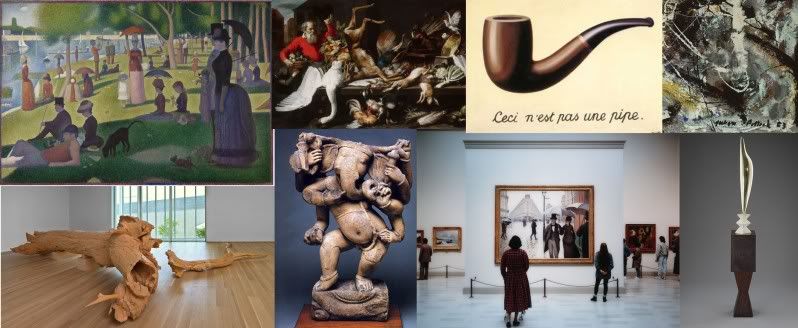After our first couple of weeks of training, David and I had to rack our brains to put together a tour worthy of kings - or maybe a tour that really highlights some of the incredible assets of our collection. Writing a tour isn't easy, but once you get into the swing of things, know your way around the museum, and understand the breadth of our collection it begins to feel like second nature.
But how about I walk you through the steps for writing a tour? Sound good?
1)THEME: Theme is key here. Especially with student tours. Themes help you to narrow down the pool of object choices for your tour and keeps things streamlined. We tried and tried and tried some more to think of the best tour theme, and after running ourselves into a wall, we consulted Robin for some ideas, settling upon the theme of Travel and Transformation. T&T, is a tour that ventures into the stories of the art, artists, and cultures of the works we've selected, which leads me to my next point...
2)OBJECTS: Picking objects!! The Art Institute has around a quarter of a million objects in the permanent collection, of which 140,000 are architectural drawings; 70,000 works on paper; 12,000 textiles; 16,000 photographs; 3,900 paintings; 3,000 sculptures; and 15,000 decorative arts (YOWZA!).* Of course it is not possible for all of our collection to be on display, but there are quite a few objects to pick from, hence having a theme to work with narrows down the selection considerable.
The objects David and I picked include:
 |
| Cartonnage Case of Paankhenamun Egypt Third Intermediate Period, Dynasty 22 c. 945-715 BCE Cartonnage, Gold Leaf, Pigment, Human Remains Gallery: 154A |
 |
| End of The Trail James Earl Fraser (American) 1918 Bronze Gallery: 163 |
 |
| Eight Armed Dancing Ganesha India, Uttar Pradesh 10th Century CE Sandstone Relief Sculpture Gallery: Alsdorf/Bridge Gallery |
 |
| Still-life With Dead Game, Fruits, and Vegetables In A Market Frans Snyders (Dutch) 1614 Oil on Canvas Gallery: 208 |
 |
| Arrival of The Normandy Train at Gare Saint-Lazare Claude Monet (French) 1877 Oil on Canvas Gallery: 201 |
FUN FACT: The Caillebotte Paris Street: Rainy Day portrays a couple looking towards the left of the painting, which is the geographic location of this Monet painting the Gare Saint-Lazare train station. The way this painting is curated in the space aligns their pictoral view with the actual train station.
 |
| Hinoki Charles Ray (American) 2007 Wood Carving in Japanese Cyprus Gallery: 292B |
3) ORDER: The order of the tour is also extremely important. We don't want to be running the visitors around the museum in a nonsensical order. We must structure our tours to flow well, in addition to thinking about the logistics of the tour in terms of the location of each work selected within the space of the museum. Plus, having a good transition between works helps the flow of the tour.
4) PRACTICE: Practice makes perfect. Know your work. Know how to talk about it. But be flexible! Tours don't always go in the direction you expect.
5) DOUBLE CHECK THE MUSEUM: Live by this. Always check the museum before you give your tour to make sure the works you plan on discussing are still on display. It's been known that some objects grow legs and walk away overnight - so beware of gallery changes!
6) HAVE FUN!!: This is probably the most important rule to live by. Be yourself. Be comfortable. And have fun. If you are passionate and excited about what you are doing, the visitors will also become excited about their trip to the museum!!
 |
| telling the stories of Ganesha in front of the Eight Armed Dancing Ganesha sculpture |



No comments:
Post a Comment